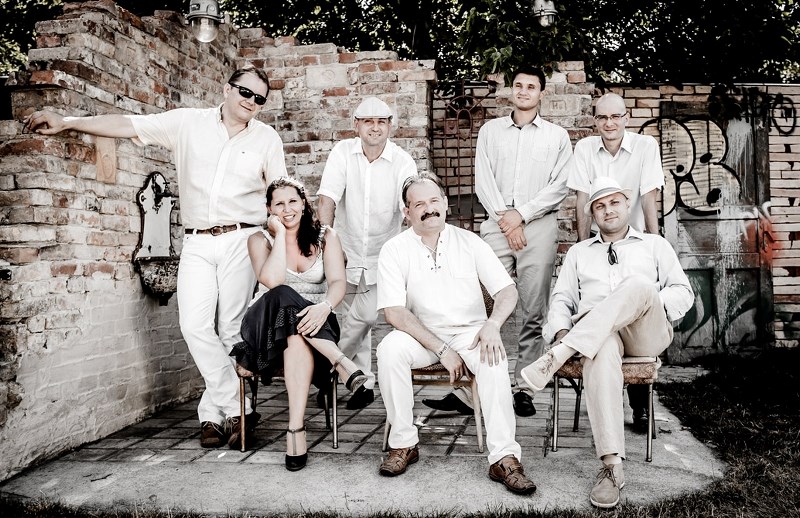It will be a rare opportunity to see a Hungarian folk institution such as CsĂk Zenekar perform at St. Albert’s Arden Theatre tonight.
Virtually unknown to North Americans, they are the heart and soul of Hungary. On a first-time tour to North America, they will visit the capital region to celebrate the 60th anniversary of the 1956 Hungarian Revolution.
Playing to appreciative Budapest audiences since 1988, they differ from many Hungarian folk bands that stick to traditional material.
The seven-piece mixes elements from Hungarian pop, underground hits, gypsy tunes, American swing and jazz, and classical selections into new and interesting tracks that form a new genre of world music.
“CsĂk is at the forefront of the meeting point of Hungarian traditional music and the modern jazz and pop realm. They have such a depth of experience in folk music, and they have such a unique style that creates an unforgettable experience,” said Susanna Biro, board member for the Canadian Hungarian Cultural Society.
The society, in partnership with the Wirth Institute for Austrian and Central European Studies hosts the iconic musicians as part of a weeklong series of anniversary events throughout the region.
CsĂk draws crowds anywhere from intimate clubs and concert halls to stadium shows and a massively populated open-air festival primarily across Europe.
But their world popularity received a huge boost representing Hungary as cultural ambassadors at the 2000 Olympic Summer Games in Sydney, Australia.
In a linear note from one of his records, primás (leader) and violinist Janos CsĂk states there is no need for vast explanations about the music.
“The music will tell you everything,” he writes.
Unlike North American folk music, Hungarian folk music is woven deep into the national identity often influenced through politics.
For instance, the 1956 uprising occurred on Oct. 23 when students marched through central Budapest to the Parliament buildings. When state police fired upon demonstrators, one student died and was wrapped in a flag and raised above the crowd.
A revolution had started. Violence and disorder swept through the capital and spread like wildfire across the country.
The Soviet-controlled Hungarian government collapsed and the Soviet Politburo spoke about withdrawing troops. However, on Nov. 4, a large Soviet force invaded Budapest. By Nov. 10, nearly 2,500 Hungarians and 700 Soviet troops were killed.
Political repression and economic decline followed. Hungarians responded with a quiet revolution searching for their roots buried in the country’s rich traditional folklore.
“All the Russian satellite countries were under the flagship Russian ballet system. Dance was a very balleticized, formalized, and a beautiful version of folk dance. It was a style but it was also a political statement,” said Biro.
Ethnomusicologists and music researchers visited Hungarian villages and spoke with elders to discover the roots of Hungarian dance.
“They were getting back to the essence of music and discovered an incredibly rich tradition that dates back hundreds of years, and it varied in every village. They catalogued entire dance cycles and musicians learned to play them from beginning to end.”
This opened up a new chapter in Hungarian culture. Musicians played the dance cycles at “dance houses” where entire families would attend for an evening’s entertainment.
“It was a sort of built-in political movement – a way for people to express their Hungarianness. It was not something taught at university. Instead it was frowned upon because it identified with the people.”
CsĂk Zenekar began by performing at dance houses. However, by blending popular music styles into traditional rhythms, they proved music could capture even the hearts of disenfranchised urban youth who were unfamiliar with rural culture.
Another of CsĂk’s choice inspirations was the addition of vocalist Marianna Majorosi.
Both a dancer and vocalist at the Hungarian State Folk Ensemble, Majorosi eventually relinquished footwork due to a large number of singing requests.
“She had learned both dances and the melodies. But it was recognized that although she was a fine dancer, her real artistic gift was in singing.”
Her bell-like voice captures the essence of the Hungarian soul with its bittersweet characteristic of making merry while shedding tears.
“What I hear is a richness and great colour. It’s not an operatic voice. It’s rich warm, pure and clear.
Rounding out CsĂk Zenekar is Attila SzabÄ‚Ĺ‚ (guitar-violin), Tamás Kunos (viola), PĂ©ter MakÄ‚Ĺ‚ (wind), Zsolt Barcza (cimbalom-accordion) and JÄ‚Ĺ‚sef BartÄ‚Ĺ‚k (double-bass).
Preview
CsĂk Zenekar<br />Wednesday, Oct. 26 at 7 p.m.<br />Arden Theatre<br />5 St. Anne Street<br />Tickets: $25 at PayPal or csardasedmeonton.com




